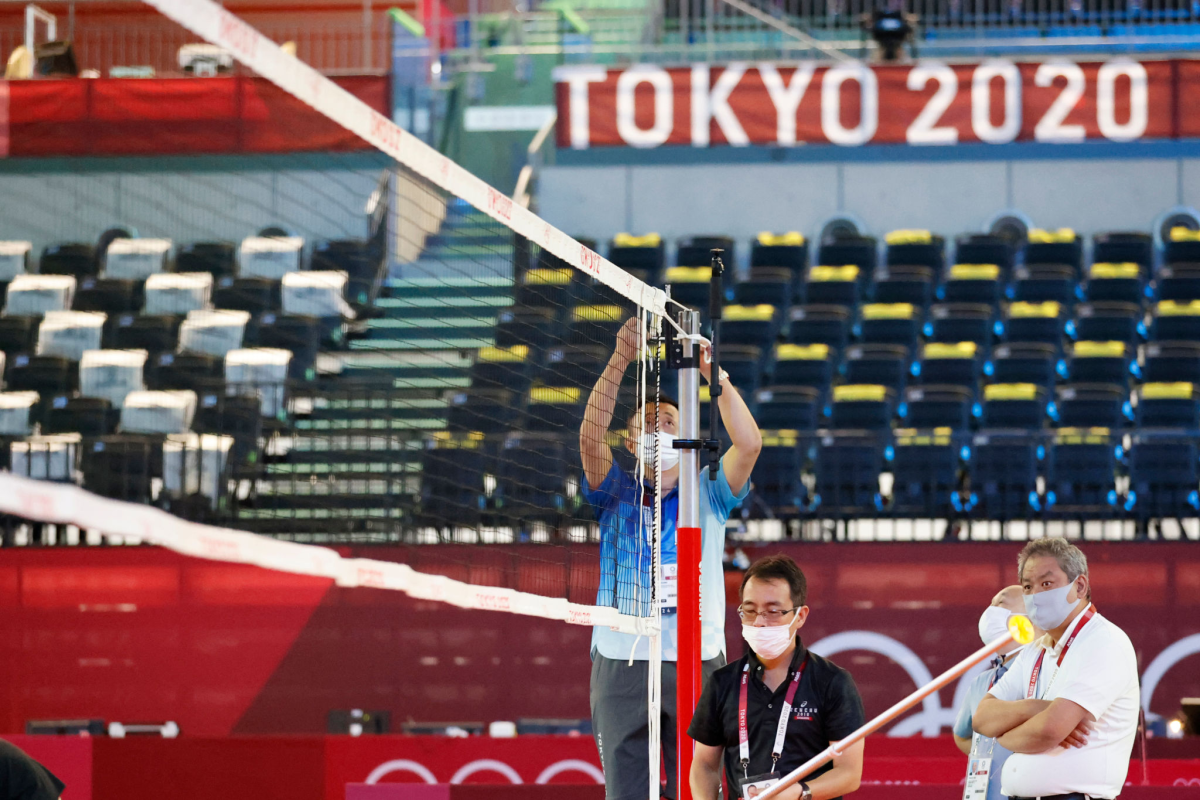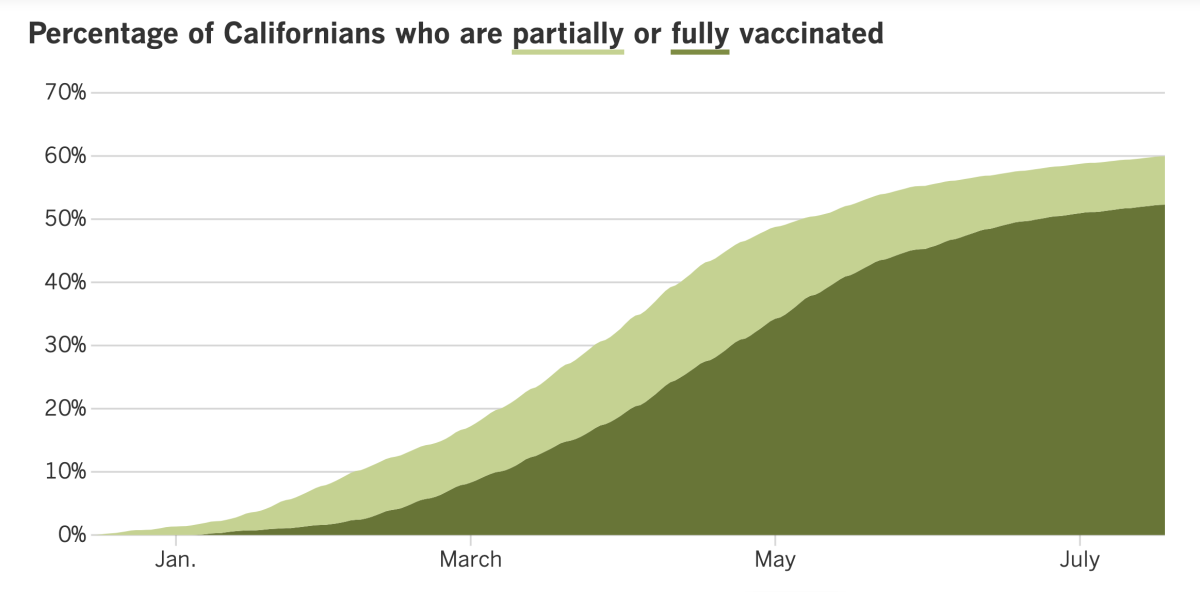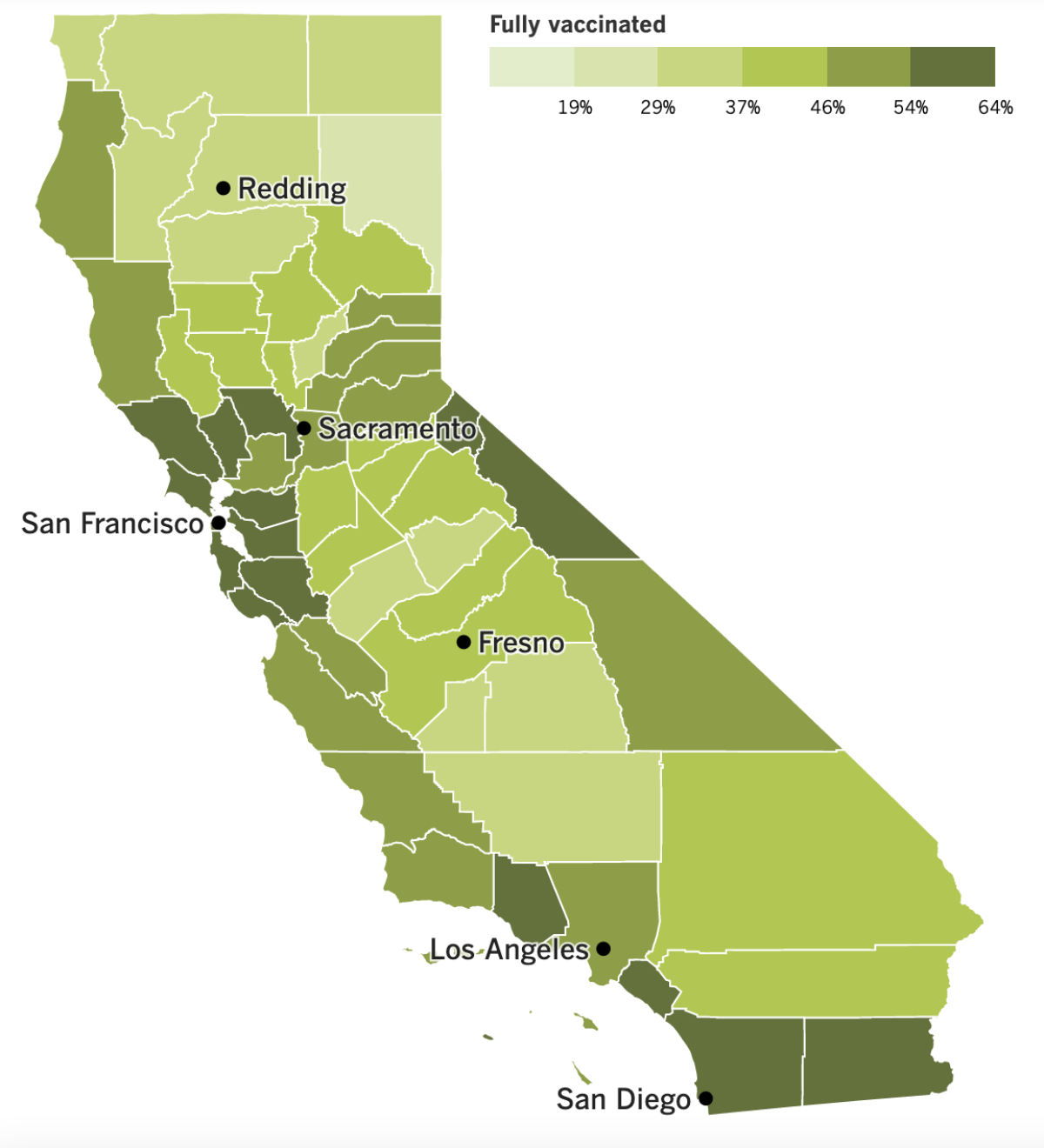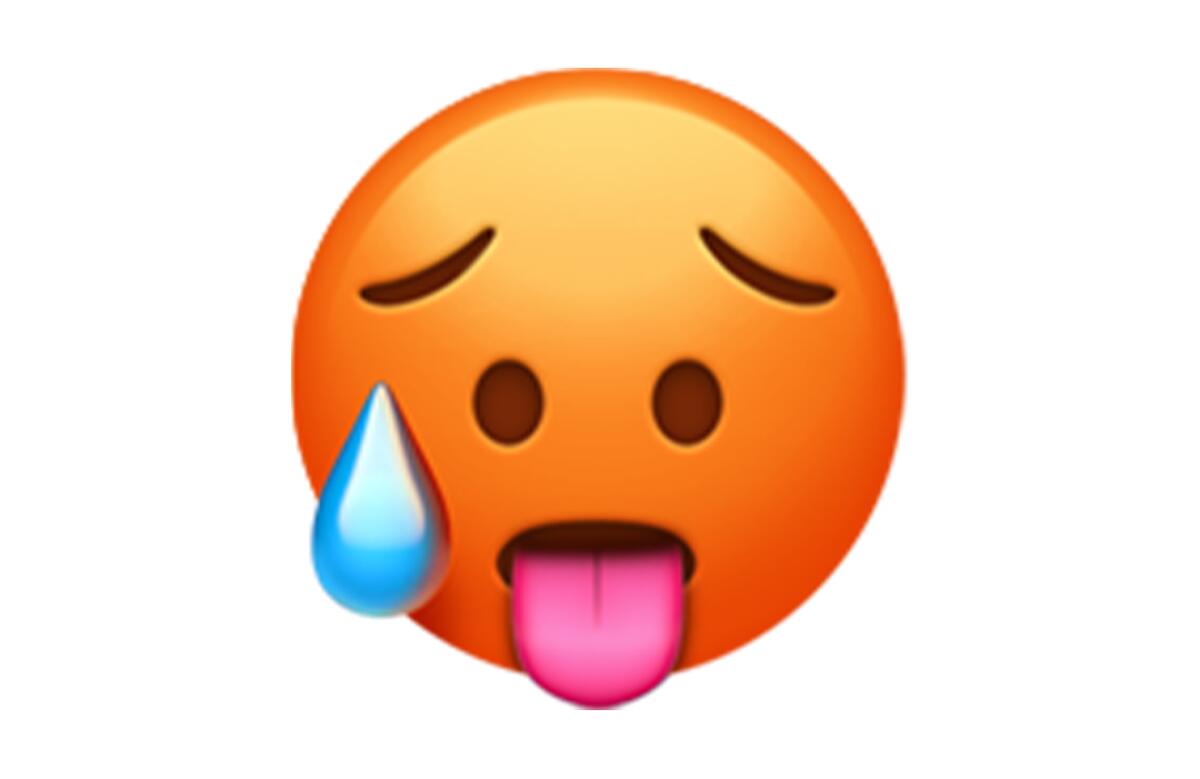Coronavirus Today: Get ready for the Pandemic Games
Good evening. I’m Karen Kaplan, and it’s Tuesday, July 20. Here’s what’s happening with the coronavirus in California and beyond.
Olympic athletes are used to constant medical testing. Normally, those tests are looking for evidence that a competitor has used a forbidden performance-enhancing substance. At the Tokyo Olympics, the more nerve-racking tests are the ones to detect the coronavirus.
For the past few weeks, thousands of athletes — along with their coaches, sporting officials and members of the media — have been spitting into plastic tubes so their saliva can be analyzed. If the coronavirus is detected, the sample is subjected to a more sensitive test, and if it’s positive again, a nasal swab is ordered.
As of Tuesday, at least 71 people associated with the Olympics have been found to be infected. They include American tennis player Coco Gauff (who was still in the U.S. when she tested positive) and U.S. gymnast Kara Eaker (an alternate who was training in Japan at a facility apart from her teammates).
Two members of South Africa’s men’s soccer team tested positive inside the Olympic Village in Tokyo. That’s the type of scenario that has Olympic officials, Japanese government officials and members of the public worried that the Games could become a superspreader event.
The powers that be have taken precautions to prevent that, my colleague David Wharton reports. People with confirmed infections must isolate in government-run hotels. Their close contacts are traced with GPS apps on their mobile phones and forced to quarantine as well.
To reduce potential exposure, athletes are encouraged to arrive in Tokyo just five days before their first event and to depart within 48 hours of their last one. That will keep the Olympic Village census around 6,000 at its peak in the middle of the Games; it was designed for 17,000 people.
People associated with the Olympics can’t dine out or visit tourist attractions; they’re limited to hotels and other official sites to minimize their contact with the Japanese public.
This is why the Games will be played without spectators. Instead of fans in the stands, the Olympic Broadcasting Services will pipe in recordings of cheering crowds. There will also be large video screens showing people watching the action from afar, plus “cheer maps” showing places in the world where people are following along.

“We do not want athletes to feel alone in the stadiums,” said International Olympic Committee President Thomas Bach. “We want to show them that many people are with them, that they are supporting them.”
Bach insists precautions like these will keep the Olympics and the host country safe. But infectious disease experts have their doubts.
Michael Osterholm, the director of the Center for Infectious Disease Research and Policy at the University of Minnesota, has advised the IOC and Japanese health officials about coronavirus countermeasures. He told sports columnist Dylan Hernández he still has “major concerns” about the Games, especially in light of the highly transmissible Delta variant.
One thing that troubles Osterholm is the organizers’ apparent reliance on outdated science. Their safety plans are based on the idea that the coronavirus spreads primarily as respiratory droplets instead of as airborne aerosols. That means there will be all-but-useless plexiglass barriers but insufficient air filters.
The ban on spectators is helpful, Osterholm said, but he hasn’t seen a detailed plan about how to handle the local staffers and volunteers who will be going in and out of the “Olympic bubble.”
Considering that daily infections in Japan are trending up and cases in Tokyo are at a six-month high, it’s not an idle concern. Japan has recorded more than 15,000 deaths during the COVID-19 pandemic, and three out of four of them have occurred in 2021. That helps explain why the Japanese public is anxious about hosting the Games and there have been widespread calls to cancel them.
That won’t happen. Competition in baseball, softball and soccer begins Wednesday local time, and the opening ceremony is on Friday.
Despite his reservations, Osterholm said he is rooting for the Olympics to succeed: “I mean, the world needs that moment right now. We need it.”
By the numbers
California cases, deaths and vaccinations as of 4:37 p.m. Tuesday:

Track California’s coronavirus spread and vaccination efforts — including the latest numbers and how they break down — with our graphics.
How to make a case for COVID-19 vaccines
Health experts and public officials still agree that vaccines offer the safest path out of the pandemic. They’re already free and widely available. They’ve been safely administered to millions of people. There’s plenty of real-world data showing that they work. California and other states even staged multimillion-dollar giveaways to entice people to prioritize the shots.
Yet finding new people to vaccinate seems to get harder each day. You can see it in the graphs that show the percentage of Californians who are partially or fully vaccinated — the curves are getting flatter because the pace of vaccinations has slowed.
The number of fully vaccinated people in California increased by 4.4 million during March and by 5.9 million during April, according to Times data. But in May, only 4.5 additional Californians joined the fully vaccinated list, even though eligibility had expanded and vaccine supply was plentiful. In June, just 2.1 million more people in the state became fully vaccinated.
Roughly 4 million Californians have yet to receive their first dose. Some of them are young children who aren’t eligible for the vaccines, and a relatively small number of adults can’t get them for medical reasons. That still leaves plenty of people who could be vaccinated if they were so inclined.
What will it take to change their minds?
A big part of the answer is more, and better, outreach. This means sending trusted people — doctors, nurses, community organizers, religious leaders — out into the world instead of waiting for vaccine-hesitant people to come to them.
It sounds straightforward, but it’s time-consuming. It means showing up at events and knocking on doors, then spending however long it takes to answer people’s questions and talk through their concerns. Ideally, when these vaccine advocates succeed, they can administer a shot on the spot.
San Francisco’s outreach to the Latino community should serve as inspiration. As of Monday, 72% of the city’s Latino residents have received at least one dose of COVID-19 vaccine. That puts them ahead of the 65% of white residents who are at least partially vaccinated. (Both groups lag behind Asian Americans, 78% of whom have gotten at least one dose.)
“It is the linking to the conversation to the actual getting of the shot — and getting the shot from somebody you know and trust — that are the one-two punch to get the job done. And it has been working,” said Dr. Kirsten Bibbins-Domingo, an epidemiologist at UC San Francisco. “It’s just a slow strategy,” she added, and “there are no shortcuts.”
Dr. Christina Ghaly, Los Angeles County’s health services director, noted that personal relationships are key because so much of this work involves combatting the misinformation that surrounds the vaccines.
“One-on-one conversations — it’s very labor-intensive, not always very fast, it takes time. But that’s been the best thing that has really helped,” she said.
Dr. Tom Frieden, who served as director of the Centers for Disease Control and Prevention under President Obama, has honed a list of five facts that have proved persuasive to vaccine skeptics:
— The risks that come with a coronavirus infection are “vastly higher” than the risks of getting vaccinated.
— The coronavirus will stay in the body of a COVID-19 patient for at least a week, but the vaccine disappears quickly.
— Almost every doctor in the U.S. chose to get vaccinated as soon as they were eligible to do so.
— The faster vaccination rates rise, the faster the economy will bounce back.
— At least 100,000 COVID-19 deaths in the U.S. can be averted in the coming months if people choose to get vaccinated now.
(To get an idea of how powerful these facts are, check out Act 2 of this recent episode of “This American Life.”)
Some people are willing to be vaccinated but still lack access to the shots. It may seem like the vaccine is ubiquitous, but that’s not the case for those who work too many hours to squeeze in an appointment, or who are too far away from a vaccine clinic or pharmacy. If health officials want to reach them, they’ll need to bring the vaccine closer to their jobs or deeper into their neighborhoods — something L.A. County and others are working on.
If the upside of being vaccinated isn’t enough, it may help to make them see the downside of remaining unvaccinated. For instance, employers could offer workers a choice: Get vaccinated or submit to a coronavirus test every day.
“When being vaccinated becomes the more convenient of the two options, that will drive people to be vaccinated,” Bibbins-Domingo said. “You have to make it slightly less convenient to be unvaccinated.”
Ready to change your mind and get your shot? Check out our updated guide to getting vaccinated in Southern California and around the country.
California’s vaccination progress


See the latest on California’s vaccination progress with our tracker.
Consider subscribing to the Los Angeles Times
Your support helps us deliver the news that matters most. Become a subscriber.
In other news ...
Gov. Gavin Newsom faces a recall election on Sept. 14. Can he make it through the next eight weeks without imposing a statewide mask mandate for all indoor public places?
It’s hardly an idle question. Unhappiness over the way Newsom shut down the state’s economy in an attempt to contain the coronavirus led to the recall election in the first place. The economy may be open now and more than half of Californians fully vaccinated, but the Delta variant is here to remind us all that we’re not out of the woods yet.
With Delta fueling a startling increase in coronavirus cases and COVID-19 hospitalizations, a growing number of counties are asking everyone to wear masks indoors, regardless of their vaccination status. (For more on the rationale behind this, see the reader question below.) Six counties — Monterey, Napa, Santa Barbara, San Benito, Santa Cruz and Ventura — joined the list Tuesday, bringing the total to 17.
So far, Los Angeles is the only county that isn’t merely asking everyone to mask up indoors but requiring it. Pasadena, which has its own public health department, said it would institute a universal mandate later this week as well.
When asked if the state might follow suit, Newsom dodged. On the one hand, he seemed happy to let counties take the lead — and the heat. He said he was “committed to not imposing new restrictions.” But he also said he was “committed to addressing this latest increase in the number of new cases here in the state of California.”
If the situation continues to worsen, he said, “some form of requirements or recommendations” would be “inevitable.”
The doublespeak is understandable. Newsom’s political opponents would be energized by any new restrictions, said Mark DiCamillo, director of polling at UC Berkeley Institute of Governmental Studies. Though the recall effort wasn’t looking good in recent polls, the calculus could change if those who want to replace Newsom see more incentive to go to the polls.
“The imposition of these kinds of mandates doesn’t sit well with that portion of the electorate,” DiCamillo said.
It was just last week that the governor was grappling with a universal mask mandate in California schools. For a few hours, it looked like the state was planning to bar K-12 students from school campuses if they refused to wear a face mask (unless they had a medical exemption). That was soon revised to let local school officials come up with their own enforcement policies.
Newsom brought the whole thing up again Tuesday by pointing out that new guidance from the American Academy of Pediatrics advises students and staff to wear face masks on school grounds regardless of their vaccination status (unless there’s a medical reason not to). The AAP is now “basically aligned” with the state, he said.
Many opponents of mask mandates have complained that there’s little point in getting vaccinated if they have to wear face masks anyway. The biggest benefit of the shots is that they can save your life, but if that’s not enough, how about this: If you’re a fully vaccinated American, you’ll soon be allowed to visit Canada.
The new policy goes into effect on Aug. 9, eliminating the need for a 14-day quarantine if you satisfy the criteria. Fully vaccinated people from other countries will get the same privilege starting Sept. 7, the Canadian government announced Monday.
England is several steps ahead. The country lifted most of its remaining coronavirus restrictions on Monday — or “Freedom Day,” as the local media called it.
Face masks are no longer required, and with social distancing rules shelved, nightclubs, theaters and other businesses were able to operate normally in nearly 18 months. Yet while champagne corks popped and dance beats boomed, infectious disease experts fretted that the lack of restrictions would pave the way for yet another coronavirus surge. Even though more than half of all Britons are fully vaccinated, hundreds of thousands of people — including U.K. Prime Minister Boris Johnson — have been told to quarantine because they’ve been exposed to someone with a confirmed infection.
“I can’t think of any realistic good scenario to come out of this strategy, I’m afraid,” said Julian Tang, a clinical virologist at the University of Leicester. “I think it’s really a degree of how bad it’s going to be.”
In India, most experts believe the official death toll of 414,000 is a vast undercount. But a new report from the Indian government’s former chief economic advisor says the true count is somewhere between 3 million and 4.7 million between January 2020 and June 2021.
The report, which was coauthored by researchers at Harvard’s Center for Global Development, acknowledges that a truly accurate count may be impossible. But based on what is known, the pandemic is likely the worst human tragedy to befall modern India.
And in France, more than 100,000 people took to the streets this weekend to march against government rules for COVID-19 vaccines. Some protesters wore yellow stars and likened themselves to Jews living in Nazi Germany.
It was too much for Joseph Szwarc, a French Holocaust survivor. He tried to give the protesters some perspective at a ceremony commemorating victims of antisemitic and racist acts by the French government, which had collaborated with the Nazis.
“I wore the star. I know what that is. I still have it in my flesh,” Szwarc said with tears in his eyes. “This comparison is hateful. We must all rise up against this ignominy”
Your questions answered
Today’s question comes from readers who want to know: If COVID-19 vaccines work so great, why do vaccinated people need to mask up indoors?
It’s a logical question, considering we’re reported over and over again that 99% of new coronavirus infections are in people who haven’t been vaccinated.
Even considering the mix of variants now circulating in L.A. County, the vaccines have been holding their own. Of the 4.67 million Angelenos who are fully vaccinated, only 0.06% later tested positive for an infection, 0.004% required hospital care and 0.0004% died of COVID-19.
But coronavirus cases are now six times higher than they were when the California economy reopened on June 15, and COVID-19 hospitalizations have doubled. Health officials hoped to reverse that trend by asking people to wear face masks in indoor public settings, but the honor system didn’t work as well as they’d hoped. So now the request has become a mandate.
Requiring masks of everyone makes the rule easier to enforce. Businesses don’t need to ascertain the vaccination status of their customers — if they’re inside, they need to wear a face mask. The same goes for offices, government buildings and other indoor spaces.
A mandate will also help make universal indoor masking a social norm — at least, that’s what health officials hope will happen.
In both cases, the goal is to get unvaccinated people to wear masks indoors. Vaccinated people just have to go along with it too.
So far, Los Angeles is the only county in the state to have graduated to a mandate. But if the situation doesn’t improve, others may follow.
We want to hear from you. Email us your coronavirus questions, and we’ll do our best to answer them. Wondering if your question’s already been answered? Check out our archive here.
The pandemic in pictures

We don’t yet have a word that captures what my colleague Julissa James so astutely describes as “the emotional chaos of our not-really-post-but-wish-it-were-post pandemic summer.” But luckily, we have the hot face emoji.
It’s a combination of joy and anxiety in one succinct package. I mean, it feels like the worst is over. But what if the Delta variant — or one that’s even worse — comes along and we’re back at square one?
To see why this emoji is so perfect for our times, consider this scenario as described by James:
“You’re in a big group of friends that you haven’t seen in over a year and you’re basking in a mixed feeling of deep happiness and screeching social anxiety: hot face emoji.”
Or this one:
“You’re getting ready to go on an in-person date with someone you’ve been chatting on Hinge with for months and they reveal that they’re not vaccinated: hot face emoji.”
You can tell we need an emoji like this because Apple (whose version is above) isn’t the only one to have it. Check out two others below. Notice they all feature worried brows, sweat beads and copious amounts of orange. Any one of them encapsulates what it feels like to be feeling one’s way through the Summer of 2021.

Resources
Need a vaccine? Sign up for email updates, and make an appointment where you live: City of Los Angeles | Los Angeles County | Kern County | Orange County | Riverside County | San Bernardino County | San Diego County | San Luis Obispo County | Santa Barbara County | Ventura County
Need more vaccine help? Talk to your healthcare provider. Call the state’s COVID-19 hotline at (833) 422-4255. And consult our county-by-county guides to getting vaccinated.
Practice social distancing using these tips, and wear a mask or two.
Watch for symptoms such as fever, cough, shortness of breath, chills, shaking with chills, muscle pain, headache, sore throat and loss of taste or smell. Here’s what to look for and when.
Need to get tested? Here’s where you can in L.A. County and around California.
Americans are hurting in many ways. We have advice for helping kids cope, resources for people experiencing domestic abuse and a newsletter to help you make ends meet.
We’ve answered hundreds of readers’ questions. Explore them in our archive here.
For our most up-to-date coverage, visit our homepage and our Health section, get our breaking news alerts, and follow us on Twitter and Instagram.




